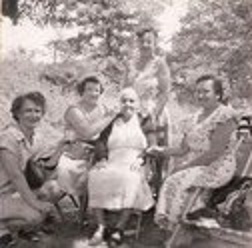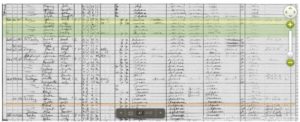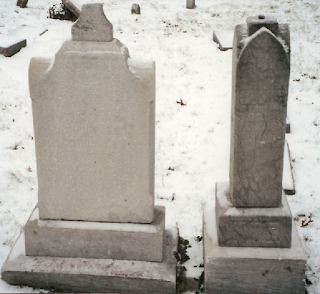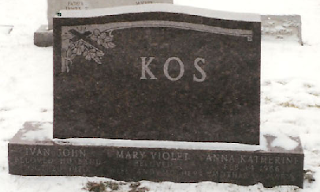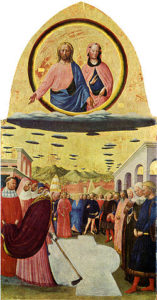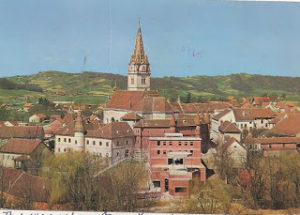
Like me, you were probably interested in exploring the 1950 US Federal census that was unveiled by NARA on April Fools Day. Finding my maternal grandparents, the joke was on me!
Above you can see under Charles and Theresa Bauer, their next-door neighbors, that my family wasn’t found at home by the enumerator. No surprise there since I knew my relatives so well. My mother was still living in the home and she and my grandfather were likely at work.
My grandmother had a weekday routine that never varied. Monday she would rise early and wash clothes in an old wringer Maytag and then hang them outside to dry. By the next census, she had an electric washer and dryer but never used them, preferring the wringer washer until she moved from the home in 1973. Tuesday was baking day. Wednesday was mending day. Thursday was grocery day. Friday was cleaning day until I got older and the task was turned over to me to do on Saturday mornings.
After Non was done with her “job” for the day she would begin cooking dinner. She had a gas stove with a well so whatever she made stayed warm until supper.
As soon as the food was done the rest of the day was hers to enjoy. Unless there was a snowstorm you wouldn’t find her at home. She loved to visit her many friends and shop till she dropped. Occasionally, she would have the “ladies” come over to her home to visit; I know that didn’t happen on 25 April 1950.
My husband knew my grandmother well and when I said, “Guess where Non was on the day of the 1950 census.” he replied, “Not home.” Yep, pretty much.
By looking at the page number I can gauge that my grandparents’ house was not one of the first stops for the enumerator that day. He likely came by after 11:00 AM that Tuesday. If he had come back by 4:30 PM someone would have been home.
Not surprising, my paternal grandmother was home that day and provided the enumerator with the information; my dad and grandfather were at work. She was likely reading when the enumerator stopped by. I’ll never know that for certain but I did know here routines. My husband’s grandparents seem to have been missed. Sigh.
Looks like many people were out and about the day the census was taken. If you find yourself in that situation, don’t despair. Look at the notation after “No one at home.” It refers you to another page (sheet) in that document. All I had to do was go to page 74 to find the information. Remember, the sheet number is in the upper right-hand corner of each page; it is NOT the image number. My image number happens to be 29 of 31. Here’s what I find:

Surprise, surprise – there is one person I hadn’t expected to find living in the household! Frank Trputec was a boarder. During the Great Depression, my family turned their old farmhouse into a boarding house to make ends meet. I had thought all the boarders had left by 1950 but apparently not.
I vaguely remember Mr. Trputec. I was told he bought my favorite stuffed animal, a spotted dog that would squeak when you pinched his tail, for my first Christmas. It’s the only stuffed animal I ever kept. I remember him coming to parties at my grandparent’s home when I was young. I can still visualize him sitting at the kitchen table next to my grandfather. He was a quiet, gentle, and kind man.
Mr. Trputec, however, was not a “cousin” as listed on the census. Well, not in the genealogical sense. In my family, everyone was considered a cousin. Sure, we’re all related so close friends and neighbors of my family were given the endearing titles of cousins. My grandmother’s closest lady friends were often called, Kuma, Croatian for Godmother. Except they hadn’t been officially deemed as Godmother for my grandparent’s four children by the Roman Catholic Church on any documents I’ve ever found. Likely, they were just good role models for the children growing up. My family really believed in “It Takes A Village.”
Mr. Truputec never married or had children so as he got up there in years, I can understand why he remained in my grandparent’s household. They kind of sort of adopted him. He became pseudo-family.
My point here is that any document we find does not tell the whole story. In 50 years a descendant will look at the 1950 census with a different perspective than I do because they had no intimate background knowledge of the individuals listed. They may wonder why no one was home and how Frank Trputec was related. If they discover he wasn’t related they may think my family was trying to hide that they were renting out a room. His relationship can easily be identified as “lodger” in the 1940 US federal census. In the intervening 10 year time period, he became “family.”
Keep this in mind when you are analyzing documents for the family members you do not know well. Do your future family a favor and write down your interpretation of documents you find for people you know well. There’s often a back story that is just as important as the “factual” documents you discover. Happy Hunting!




